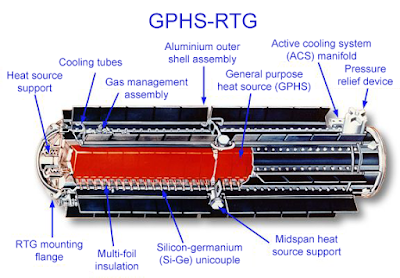ISRO made RTG for deep space mission
ISRO made Radioisotope Thermoelectric generator RTG
Nuclear Power in space
It provides an enormous amount of energy and to tap into nuclear's potential India's premier space organization is the Indian space research organization ISRO in the process to develop a Radioisotope Thermoelectric Generator to embark on a monumental journey to explore remote and challenging environments of the deep space missions.
ISRO leading center for the design and development of all satellite U R Rao Satellite Centre has proposed a three-phase development of 100 watts of radioisotope thermoelectric generator the center envisions the use of RTG technology for the power generation and thermal management of ISRO's deep space missions further isro plans to set up a space center along with various missions in the pipeline such as the first human space flight mission Gaganyan, India's first attempt of solar observatory missions L1, Mangalyan 2, to mars Chandrayaan-3, has a real-time to land on the moon amongst others the RTG technology will come in handy in these deep space missions
RTGs used in NASA missions
If you want to drive a rover on Mars, you have to keep in mind there's no gas station for millions of kilometers and there's no outlet to plug into for power. That's why NASA's Perseverance rover on Mars --and other NASA spacecraft that explore the solar system-use something called "radioisotope power."A radioactive substance releases heat as it breaks down or decays. A system that converts that heat into electricity is called a radioisotope power system.
Understanding Radioisotope Thermo-electric Generator (RTG)
Radioisotope Thermoelectric Generator or RTG is a type of nuclear power battery that uses an era of thermocouples to convert the heat into electricity the generator is governed by the sea back effect and it generally has no movable parts.
sec back effect is a phenomenon in which a temperature difference between two dissimilar electronic conductors or semi-electric conductors produces an electromotive force in simple words that is electricity.
RTGs are highly reliable and maintenance-free because there are no movable parts in thermocouples that reduce failure and wear out.
How it will shape the prospects of future space mission
Understand the working of RTG
let us first know the working of a normal satellite the normal satellites are sent into space in various stages in the initial stage the satellite takes off with a strap-on booster's followed by loosening of the boosters by the satellite in the second stage in Indian satellites Vikas liquid fuel engine is used in the second stage the third stage is reached after detaching the second stage and finally the satellite is in space.
The satellites there operate with solar power energy, which is the modest Operandi of a normal satellite.
In a normal satellite, heavy carrier for energy generation makes it heavy and healthy; hence, bulky on the other hand, RTG systems use thermocouples and natural decay of radioactive isotopes into electrical energy, making it less bulky.
RTG systems are more fuel-efficient than normal satellite systems as they are less lighter than chemical rockets and thus they can travel faster and further.
Notably, since RTGs do not work on solar power they do not rely on the sun on it provides the thrust from their own energy to the satellites to function on the darker sides of the planet and that is the biggest plus.
on similar lines, ISRO's former chairman is Kiran Kumar called RTG futuristic, an unmatched alternative to solar power.
solar power is not an option for space object meant to operate on a dark side of the planet where sunlight is credited intensity is inversely proportional to the square of the distance between the cholesterol body and the sun hence space objects sent too far off mission required an alternative source of energy like RTGs.
The Genesis of RTG
nuclear and space flight have a deep and deep history that stretches all the way back to the time of the cold war in 1961 when you USA's transit mission used the technology for the first time.
The elsewhere soviet union had also launched two dozen nuclear power space objects however the budget constraints the development of alternative sources of energy and the possibility of escalation of the cold war led to the containment of the nuclear professional projects.
With RTGs, isro has told the world that India isn't an asset space player instead it aims to take humans deeper into space with nuclear energy so this is it in today's section thanks.





Comments